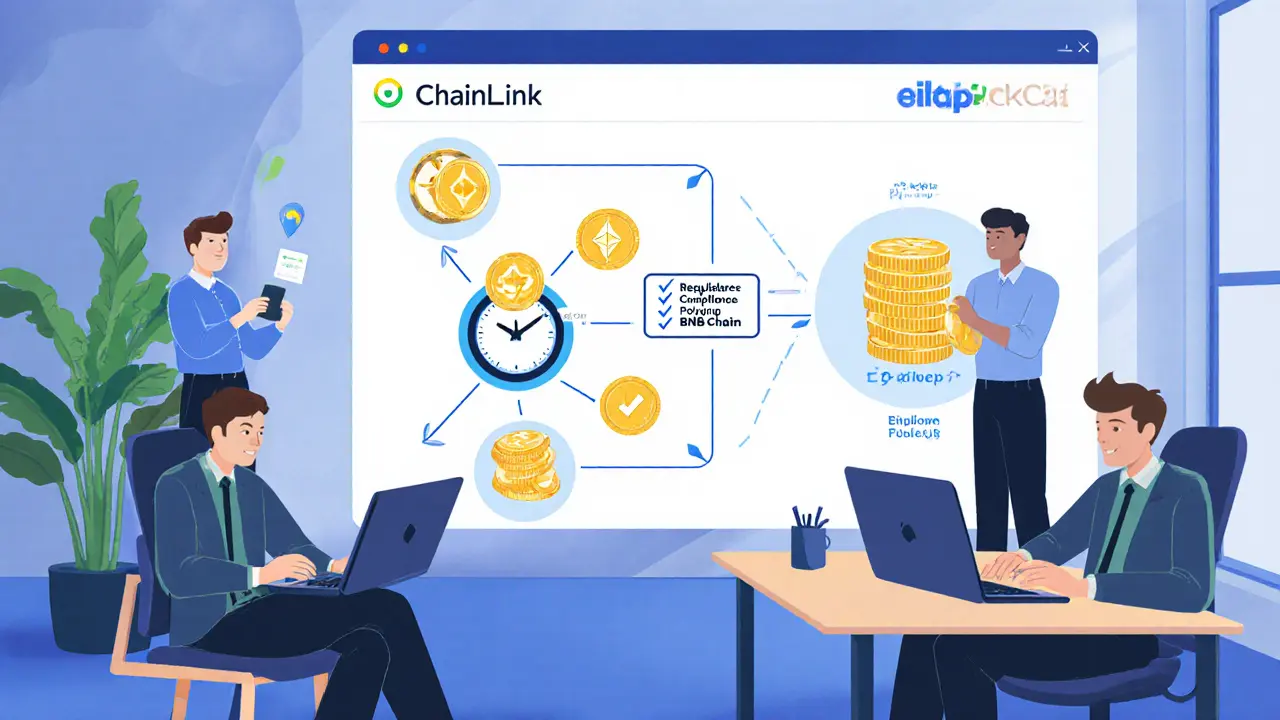Cross-Protocol Integration Selector
Select your project requirements below to get a recommended protocol for cross-chain integration.
Recommended Protocol
Protocol Comparison
Quick Takeaways
- Cross‑protocol integration lets smart contracts on different blockchains talk to each other without custodial bridges.
- Five leading protocols dominate the space: IBC, Chainlink CCIP, LayerZero, Axelar, and Wormhole.
- Performance varies widely - from sub‑30‑second finality on LayerZero to 5‑15‑minute finality on IBC.
- Security trade‑offs are real: IBC scores highest on decentralization, while Wormhole has the most historic hacks.
- Choosing a protocol depends on your use case - enterprise token transfers favor CCIP, NFT projects lean toward LayerZero, and DeFi composability often uses Axelar.
When developers talk about cross-chain integration, they’re really describing a set of communication layers that let isolated blockchains exchange data and value. The promise is simple: no more silos, unified liquidity, and fewer custodial middlemen. Yet the reality is a toolbox of very different architectures, each with its own security model, performance profile, and developer experience. This guide walks through concrete examples of how the major protocols are wired together in production, compares their strengths and weaknesses, and gives you a step‑by‑step checklist for picking the right one for your project.
Cross‑Protocol Integration is a set of standards and middleware that enable heterogeneous blockchain networks to exchange messages, assets, and state changes in a trust‑minimized way. It emerged after the 2017‑2018 blockchain boom when isolated networks started to create costly data silos.
Why Cross‑Protocol Integration Matters
Imagine a DeFi app that only lives on Ethereum. To tap into the deep liquidity on Binance Smart Chain or the low fees on Polygon, the app would need a bridge, and every bridge adds risk. By integrating a cross‑protocol layer, the same smart contract can request a price feed from a Cosmos zone, lock tokens on Avalanche, and mint a receipt on Solana - all in a single atomic flow. The market reflects this need: a 2023 Binance Research report showed a 47.3% CAGR for interoperability solutions, and Q22024 saw $25.7billion in cross‑chain transactions.
Major Protocols at a Glance
Below is a snapshot of the five protocols that dominate real‑world deployments. Each entry includes the first‑time microdata definition so search engines can recognize the entities.
Inter‑Blockchain Communication (IBC) is a native Cosmos protocol that requires 100% validator participation for message finality, delivering the highest decentralization guarantees. Launched in March2021, it now connects 78 zones.
Chainlink Cross‑Chain Interoperability Protocol (CCIP) is a permission‑less network of 50+ oracle nodes that adds risk‑management features like circuit breakers. Since its 2023 debut, CCIP processes transactions with 45‑90minute finality depending on security settings.
LayerZero is an ultra‑light node architecture that separates oracle and relayer roles, achieving sub‑30‑second finality on supported chains. Its developer‑friendly SDK lets teams spin up omnichain apps in under two hours.
Axelar Network is a proof‑of‑stake messaging layer that supports 85% of EVM chains plus Cosmos zones, enabling cross‑chain smart‑contract calls. Average latency is around 2.7minutes.
Wormhole is a guardian‑multisig bridge that validates transactions with a 33‑of‑50 signature threshold, supporting 30+ networks. It has transferred $12.4billion since 2021.

Real‑World Integration Examples
Seeing the protocols in action helps you decide which fits your stack. Below are three use‑cases that illustrate different design goals.
1. Enterprise Token Transfer - CCIP
A multinational fintech wanted to move stablecoins between Ethereum, Polygon, and BNB Chain without exposing customers to custodial risk. They chose CCIP because its risk‑management network satisfies regulatory checklists (the FCA’s July2024 paper cites CCIP’s compliance features). The integration took four days for the senior dev team, matching Chainlink’s own onboarding metrics. Finality landed at ~60minutes, and the platform achieved a 99.4% success rate on multi‑step token swaps.
2. Cross‑Chain NFT Marketplace - LayerZero
Project MetaMints built an omnichain NFT marketplace that lets creators mint on Solana, list on Ethereum, and trade on Polygon without redeploying contracts. Using LayerZero’s ULN SDK, the core logic was written once and deployed via a single Solidity interface. The marketplace reported sub‑30‑second mint‑to‑sale finality and a 99.987% success rate in Q22024, matching the protocol’s benchmark. Developers praised the simplicity, with 68% of respondents on r/ethdev preferring LayerZero for exactly this reason.
3. DeFi Liquidity Aggregator - Axelar
YieldHub, a DeFi aggregator, needed to query price feeds and execute swaps across 12 chains in one transaction. Axelar’s General Message Passing (GMP) allowed the aggregator to call a Uniswap‑like router on Ethereum, then trigger a PancakeSwap swap on BNB Chain, all atomically. The average latency was 2.5minutes, acceptable for the 24‑hour yield‑optimizing strategy. Axelar’s community support resolved a Cosmos‑SDK version mismatch in under 9 hours.
Technical Trade‑offs and Performance
Performance, security, and cost form a three‑way balance. Table1 summarizes the most relevant metrics as of August2024.
| Protocol | Typical Finality | Security Model | Supported Chains | Common Use Cases |
|---|---|---|---|---|
| IBC | 5‑15min | 100% validator set participation (gold‑standard decentralization) | 78 Cosmos zones | Inter‑zone token transfers, cross‑zone governance |
| CCIP | 45‑90min (enterprise config) | Permissionless oracle network with real‑time risk management | 40+ EVM & non‑EVM chains | Enterprise token swaps, regulated finance |
| LayerZero | Under 30s | Dual‑oracle + relayer; potential single‑point‑of‑failure if collusion occurs | 30+ major chains | NFT bridges, gaming, omnichain dApps |
| Axelar | ≈2.7min | Proof‑of‑stake validators (50+ confirmations) | 85% of EVM chains + Cosmos zones | Cross‑chain contract calls, DeFi aggregators |
| Wormhole | ≈1min | 19‑guardian multisig (33/50 signatures) | 30+ chains | Bridge token transfers, USDC integration |
Cost also varies. IBC can move a message for as little as $0.02, while CCIP’s enterprise tier may cost up to $2.85 per transaction. Throughput ranges from 5TPS on XCMP‑lite to 1,200TPS on a fully optimized LayerZero configuration.
Implementation Tips & Common Pitfalls
- Start with a clear threat model. If regulatory compliance drives you, CCIP’s built‑in circuit breakers are a boon. If you need maximal decentralization, IBC is the only protocol that truly avoids custodial intermediaries.
- Watch out for message ordering. 31% of cross‑chain projects report ordering failures, especially when using asynchronous relayer designs like LayerZero’s ULN. Implement sequence numbers or nonce checks in your contract logic.
- Allocate enough node resources. Running an IBC validator typically needs 16vCPUs, 64GB RAM, and 2TB SSD. Under‑provisioned nodes can cause stalls that increase finality time dramatically.
- Test for chain reorganizations. Cross‑chain bridges often lose messages during reorgs. Design idempotent handlers that can replay or reconcile state.
- Leverage existing SDKs. LayerZero’s Omnichain SDK, Axelar’s GMP+, and Chainlink’s CCIP SDK include pre‑written adapters for popular wallets. Skipping them means reinventing the wheel and inviting bugs.
Documentation quality matters. IBC scores 4.7/5 for thoroughness but is known for steep learning curves; Wormhole’s docs sit at 3.8/5 and are flagged for inconsistent examples. Pair your chosen protocol with a community channel that offers quick responses - Axelar’s Discord averages 8.2hours, while CCIP’s enterprise support is 24/7 for premium tiers.
Choosing the Right Protocol - Decision Guide
Use the Quick‑Decision Matrix below to match your project priorities against protocol strengths.
- Regulated finance or high‑value token swaps → CCIP (compliance‑first, but slower).
- Fast NFT or gaming experiences → LayerZero (sub‑30‑second finality, developer‑friendly).
- Maximum decentralization → IBC (validator‑set finality, limited to Cosmos zones).
- Cross‑chain smart‑contract calls across many EVM chains → Axelar (GMP+, broad support).
- Broad network coverage with existing USDC bridge → Wormhole (wide adoption, watch security track record).
Remember that you can combine protocols. A DeFi platform might use IBC for internal Cosmos‑zone settlements, then layer CCIP on top for fiat‑on‑ramp compliance, and finally add LayerZero for rapid NFT minting. The key is to avoid “protocol lock‑in” by abstracting your messaging layer behind a thin adapter.
Future Outlook
The interoperability market is projected to hit $14.32billion by 2028, driven by L1s building native cross‑chain channels and specialized infrastructure persisting as “glue” layers. Upcoming standards like Ethereum’s EIP‑7683 (cross‑chain message format) and the IETF’s Blockchain Interoperability Working Group aim to reduce fragmentation - the very risk that industry analysts flag as the biggest threat.
In the next two years, expect three trends:
- Standardized message formats. With EIP‑7683 and IBC Hooks, developers will write once‑and‑run on multiple bridges.
- Hybrid security models. Projects such as Chainlink’s upcoming CCIP1.3 blend validator sets with oracle backstops, offering a middle ground between pure decentralization and regulated compliance.
- Layer‑2‑first bridges. As rollups dominate, cross‑protocol kits will focus on L2‑to‑L2 messaging, reducing latency and gas costs dramatically.
Keeping an eye on these developments will help you future‑proof your integration strategy.
Frequently Asked Questions
What is the main difference between IBC and CCIP?
IBC is a native Cosmos protocol that requires all validators on both chains to participate, giving it the strongest decentralization guarantees but slower finality. CCIP, by contrast, uses a permission‑less oracle network with built‑in risk‑management tools, making it a better fit for regulated enterprises that need compliance features, albeit with longer settlement times.
Can I use multiple cross‑chain protocols in the same dApp?
Yes. Many projects stack protocols to play to each one's strengths - for example, using IBC for internal Cosmos‑zone transfers, LayerZero for fast NFT minting, and CCIP for compliance‑heavy token swaps. The key is to abstract the messaging layer so you can swap or add bridges without rewriting core business logic.
How much does it cost to send a message via LayerZero?
LayerZero’s cost varies by destination chain and gas price, but typical fees range from $0.10 to $0.45 per message for a standard transfer. Optimized configurations can push throughput to 1,200TPS while keeping per‑message costs under $0.20.
Is Wormhole still safe after its 2022 bridge hack?
Wormhole has implemented stricter guardian controls and added formal audits since the 2022 incident. Security scores improved from 52/100 to around 68/100 in the latest Trail of Bits analysis, but the protocol still carries a higher risk profile than IBC or CCIP, so enterprises usually pair it with additional monitoring.
What tooling do I need to run an IBC validator?
At minimum you’ll need a server with 16vCPUs, 64GB RAM, 2TB SSD, and a reliable internet connection. Install the latest Cosmos SDK (v0.51+), configure the IBC module, and join a validator set. Expect a few weeks of setup and testing before you can process live cross‑chain messages.


ചഞ്ചൽ അനസൂയ
Hey folks, this selector is a neat way to visualize the trade‑offs between IBC, CCIP, LayerZero and the rest. It lets you match your project's speed and security needs without drowning in jargon. I especially like how the security tier maps to validator participation – that’s the real decentralisation metric. If you’re building on Cosmos, the IBC path gives you the most trust‑less bridge. Overall, great tool for rapid prototyping!